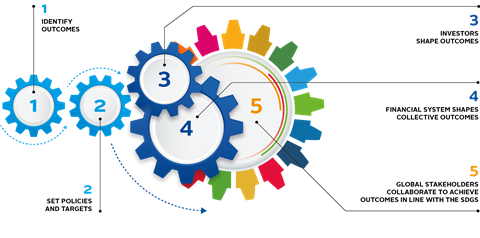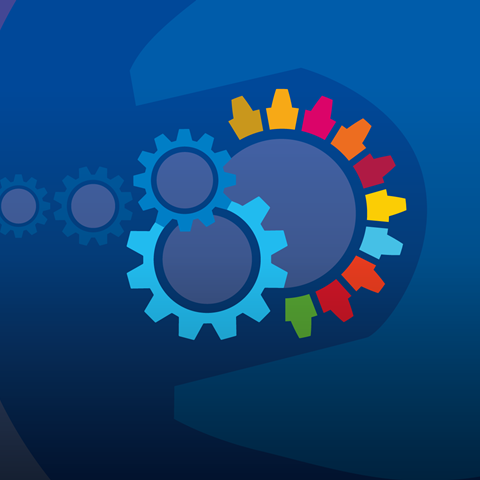A five-part framework for investors
This section:
- explains how all investor actions have outcomes in the real world – whether intended or not;
- outlines a framework of five parts from which investors wishing to deliberately shape outcomes, in line with the SDGs, can better understand how to do so;
- describes the actions that investors can take in each part of the framework;
- highlights existing initiatives, tools and data that investors can use.
All investor actions – investment decisions and the use of tools of influence – shape positive and negative outcomes in the world.
To support meeting the SDGs, investors must:
- understand the positive and negative outcomes from their investments and related activities;
- seek to shape those outcomes in line with the SDGs.
“Outcomes” can be identified and measured at the level of a particular asset, economic activity, company, sector, country or region. Progress can be assessed against recognised global sustainability performance thresholds and timeframes – including the SDG targets and indicators.
We describe “impact” as a change in outcome (i.e. an outcome shaped by an investor, in line with the SDGs).
Investor roles in outcomes
It is important to distinguish between the different roles that investors can have in relation to outcomes.
There are outcomes that an investor:
- has caused – through its own business activities (e.g. outcomes on its own employees);
- has contributed to – through a business relationship or investment activity (actions or omissions) that induces or facilitates an outcome from an investee company or project;
- is directly linked to – through the activities, products or services of an investee company or project.
While the investee company or project causing the outcome has responsibility, the investor – through its investments, and acting alone or in collaboration with others where appropriate – is in a position to use its leverage to influence the entity, with the aim of decreasing negative and increasing positive outcomes.
In practice the distinction between outcomes caused, outcomes contributed to and outcomes directly linked to is not always clear – there is a continuum between them. Factors determining where on that continuum a particular instance may sit include: the extent to which an entity facilitated or incentivised outcomes from another, the extent to which an entity could or should have known about such outcomes and the quality of any mitigating steps it has taken to seek to prevent or address the outcomes. Activities includes both actions and omission to act.
The PRI proposes a five-part framework for investors that are seeking to understand the real-world outcomes of their investments, and to shape those outcomes in line with the SDGs (Figure 4).
1. Identify outcomes
Investors individually identify and understand the unintended23 outcomes from current investment activities.
2. Set policies and targets
Investors individually set policies and targets for their intentional activities to shape important outcomes in line with the SDGs: reducing negative outcomes and increasing positive ones.
It is assumed that any current intended outcomes would already have been identified and understood (and based on existing policies and targets).
3. Investors shape outcomes
Investors individually seek to increase positive outcomes, decrease negative outcomes and measure progress toward established targets.
4. Financial system shapes collective outcomes
Investors, in aggregate and collectively, seek to increase positive outcomes, decrease negative outcomes and measure collective progress.
5. Global stakeholders collaborate to achieve outcomes in line with the SDGs
Investors work with broader stakeholders – including businesses, governments, academia, NGOs, consumers, citizens and the media – to globally achieve all SDGs.
Figure 4: Five-part SDG outcomes framework for investors

Investor actions across the framework
While the foundational work described in the first two parts of the framework will often provide the basis for actions taken in the subsequent parts, overall the framework does not rely on being followed in a particular order, and investors’ ambitions and/or commitments may be better served by pursuing opportunities selected from across the framework than by working through one part at a time.
In addition, while investors may choose to start using the framework with a particular investment product (e.g. a private equity fund), to be able to drive SDG-aligned outcomes at the global level, most investors will need to progress to focusing on outcomes across their portfolios, including through collaboration with others.
The PRI distinguishes the following set of actions through which investors can shape outcomes in line with the SDGs (applicable to Part 3 and Part 4):
- investment decisions – using information on SDGaligned outcomes in the investment decision-making process, including in portfolio construction, security selection and asset allocation, and/or in selecting, appointing and monitoring external managers/funds;
- stewardship of investees – using the right and/ or position of ownership in an asset, individually or in collaboration with other investors, to influence the activity or behaviour of investees or potential investees;
- engagement with policy makers and key stakeholders – developing or influencing market standards and wider policies set by e.g. governments, regulators, multilateral financial organisations and stock exchanges, to enables investors to shape outcomes in line with the SDGs.
These actions, and resulting outcomes, can then be communicated through disclosure and reporting from individual investors, in aggregate across the financial system and at the global level.
Tools, metrics and data
Although more support for investors needs to be developed, there are already several relevant tools, metrics and data sets, and several approaches that can be useful for investors taking action across the framework (see Appendix 1). On issues where there is a heightened sense of urgency and more developed tools are already available (e.g. climate change), there are investors already setting policies and targets as described in Part 2 and undertaking actions described in Part 3 (see Appendix 2). For example, a fund with a strategy in place to reduce all negative human rights outcomes in portfolio companies is already working across Parts 2 (defining the strategy) and 3 (implementing it).
Actions in Part 4 and Part 5 require tools to assess progress across all SDG-related outcomes, at the financial system and global level. Given the urgency with which the SDGs must be achieved, investors must work with other key stakeholders to develop the tools and incentives needed (and monitor and measure progress against them).












